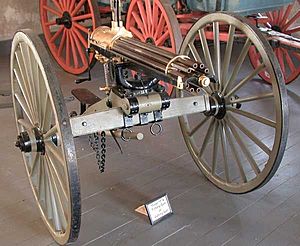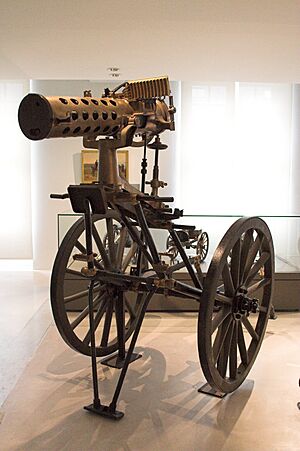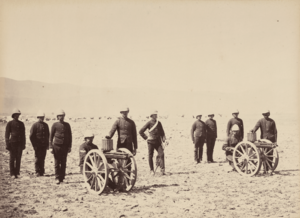Gatling gun facts for kids
Quick facts for kids Gatling gun |
|
|---|---|

1876 Gatling gun kept at Fort Laramie National Historic Site
|
|
| Type | Rapid-fire gun, hand-cranked machine gun |
| Place of origin | United States |
| Service history | |
| In service | 1862–1911 |
| Used by | See Users |
| Wars | American Civil War Boshin War Indian Wars Franco-Prussian War Anglo-Ashanti War Ethiopian-Egyptian War Haw Wars Satsuma Rebellion Russo-Turkish War (1877-1878) Second Anglo-Afghan War Anglo-Zulu War War of the Pacific Argentine Civil Wars Russian conquest of Central Asia Kiriji War Mahdist War Anglo-Egyptian War Colombian Civil war of 1884-1885 Northwest Rebellion Italo-Ethiopian War of 1887-1889 Revolution of the Park Argentine Revolution of 1893 Revolta da Armada First Sino-Japanese War Second Matabele War Spanish–American War Philippine–American War Boxer Rebellion Colorado Labor Wars Russo-Japanese War (limited) 1907 Honduran Conflict Mexican Revolution Battle of Blair Mountain |
| Production history | |
| Designer | Richard Jordan Gatling |
| Designed | 1861 |
| Manufacturer | Eagle Iron Works Cooper Firearms Manufacturing Company Colt Manufacturing Company American Ordnance Company |
| Produced | 1862–1903 |
| Specifications | |
| Mass | 170 lb (77.2 kg) |
| Length | 42.5 in (1,079 mm) |
| length | 26.5 in (673 mm) |
| Crew | Four-man crew |
The Gatling gun is a fast-firing weapon with many barrels. It was invented in 1861 by Richard Jordan Gatling. It was one of the first machine guns. It also helped lead to the modern electric motor-powered rotary cannon.
The Gatling gun worked by using several barrels that spun around. This helped keep the barrels cool. It also made sure that each barrel loaded, fired, and ejected a cartridge in order. To make it fire, someone had to turn a hand crank. As the barrels spun, each one would pick up a new bullet from a magazine on top. Then, it would fire the bullet and throw out the empty shell. This design meant the gun could shoot many bullets quickly without getting too hot.
The Gatling gun was one of the most famous early rapid-fire firearms. The Union Army used it a few times during the American Civil War. This was the first time it was used in a real battle. Later, it was used in many other wars. These included the Anglo-Zulu War and the attack on San Juan Hill. It was also used on ships.
Contents
How the Gatling Gun Works
The Gatling gun uses a hand-crank to work. It usually has six barrels that spin around a central pole. Some models had up to ten barrels. Each barrel fires once during every full spin. The barrels, a part called a carrier, and a lock cylinder were all separate. They were mounted on a strong plate that spun around a central pole. This pole was held by a fixed frame. Turning the crank made the pole spin.
Inside the gun, a special part called a cam moved the firing pins forward. This loaded the bullet. When the cam reached its highest point, the gun fired the bullet. After firing, the cam pulled the firing pin back. This made the empty shell drop out of the gun.
Before the Gatling gun, it was hard to make guns with many barrels work well. This was because they didn't have good engineering. Also, they didn't have a single, easy-to-use cartridge. Early Gatling guns used steel cylinders that could be reloaded. These cylinders held a bullet and gunpowder. As the barrels spun, these cylinders dropped into place, were fired, and then came out. The Gatling gun was special because each barrel had its own firing part. All the parts worked together smoothly.
At first, Gatling guns used paper cartridges. These were filled with black powder. They were fed into the gun from a hopper or a simple box on top. Each barrel had its own firing system.
Later, in 1881, Gatling guns started using brass cartridges. They also got a new feeding system called the 'Bruce' system. This system could hold two rows of bullets. While one row was being fired, the other could be reloaded. This allowed the gun to fire continuously. By 1886, the gun could fire over 400 bullets per minute.
Some smaller Gatling guns used a "Broadwell drum" for bullets. This drum held 400 bullets in 20 stacks. As one stack emptied, the drum was turned to use a new stack.
By 1893, the Gatling gun was updated to use new smokeless cartridges. These new guns had six barrels, then later ten barrels. They could fire up to 900 bullets per minute. But 600 bullets per minute was suggested for continuous firing. Dr. Gatling even made some guns work with an electric motor. These electric Gatlings could fire up to 1,500 bullets per minute!
The M1895 model was very similar to the M1893. The U.S. Army bought 94 of these guns. Four M1895 Gatlings were used in Cuba in 1898. They were very helpful during the Santiago campaign. The M1895 guns were painted olive drab green.
The Model 1900 was like the 1895 model. The U.S. Army bought several of these. All Gatling guns from 1895 to 1903 could be put on an armored carriage. In 1903, the Army changed its M1900 guns. They were updated to use the new .30-03 cartridge. Later, they were changed again to use the .30-06 cartridge. The U.S. military stopped using all Gatling guns in 1911. They had been in service for 45 years.
The first Gatling gun was a field weapon. It had many spinning barrels turned by a hand crank. It fired metal bullets that were not linked together. They dropped into the gun using gravity feed from a hopper. The Gatling gun was special because it used many barrels to stop overheating. It also had a spinning part and a gravity-feed system. This allowed people who weren't highly trained to fire about 200 bullets per minute.
Even though the first Gatling gun could fire many shots, someone had to crank it. So, it wasn't a true automatic weapon. The Maxim gun, invented in 1883, was the first fully automatic weapon. It used the force of the fired bullet to reload itself. Still, the Gatling gun was a huge step forward in firearm technology.
Before the Gatling gun, armies used "volley weapons." These guns fired many bullets at once, like a giant shotgun. But they had to be reloaded after each shot. This took a lot of time. The Gatling gun was much better. It could fire quickly and continuously without needing to be reloaded by hand.
Early multi-barrel guns were big and heavy, like artillery cannons. They were often seen as replacements for cannons that fired many small balls. Compared to older guns, the Gatling gun was more reliable. It was also easier to use. It fired at a steady rate. However, the large wheels needed to move these guns made them sit high up. This made their crews easy targets.
Firing black powder bullets created a lot of smoke. This made it impossible to hide the gun. This problem was solved when smokeless powder became available later. When Gatling guns were used against armies from modern countries, their crews were in danger. They could be hit by enemy artillery or snipers they couldn't see.
History of the Gatling Gun
Richard J. Gatling designed the Gatling gun in 1861. He received a patent for it on November 4, 1862. Gatling said he created the gun to make armies smaller. He hoped this would reduce deaths from fighting and disease. He wanted to show how pointless war could be.
The US Army used Gatling guns that fired different sizes of bullets. These included .42 caliber, .45-70, and .50 caliber. Later models used .30 Army bullets. Some guns were even changed to use .30-03 and .30-06 bullets. The .45-70 gun was also put on some US Navy ships in the 1880s and 1890s.
A British company made a changed Gatling gun around 1888. It was called the Accles Machine Gun. An American company later bought the rights to make and sell this gun. The US Navy tested it in 1895. It was said to be the only gun that passed the test. But the US forces did not seem to use it.
Early Use in the Americas
The Gatling gun was first used in battle during the American Civil War. Union commanders bought twelve guns themselves. They used them in the trenches during the Siege of Petersburg, Virginia. Eight other Gatling guns were put on gunboats. The American Army did not officially accept the gun until 1866. This was after a salesperson showed how well it worked in combat.
In 1863, Gatling guns were supposedly used to control rioters in New York. Two guns were also used against striking workers in Pittsburgh.
It is famous that Gatling guns were not used at the Battle of the Little Bighorn. Gen. George Armstrong Custer chose not to bring them with his main force.
In 1867, the Argentine Army bought a Gatling gun. This was ordered by President Bartolomé Mitre.
Captain Luis Germán Astete of the Peruvian Navy brought many Gatling guns to Peru in 1879. This was during the War of the Pacific against Chile. The Peruvian Navy and Army used Gatling guns in battles. These included the Battle of Tacna and the Battle of San Juan.
In 1885, Lieutenant Arthur L. Howard brought his own Gatling gun to Canada. He used it with the Canadian military against rebels during the North-West Rebellion.
In 1888, some Gatling guns were secretly brought into Haiti.
In 1907, Nicaragua used Gatling guns in the battle of Namasique. Many American mercenaries operated these guns.
Gatling guns were also stored by coal companies. They were used during the Battle of Blair Mountain. In 1921, a group of miners took one of these guns. They attacked a place called Craddock Fork. The other side fought back with a machine gun. But after three hours, their gun stopped working. The miners pushed forward but were stopped by another machine gun.
Use in Africa and Asia
The Gatling gun was very successful in helping European countries expand their empires. It helped them defeat local warriors who attacked in large groups. These included the Zulu, the Bedouin, and the Mahdists. Russia bought 400 Gatling guns. They used them against horse riders and other groups in central Asia. The British Army first used the Gatling gun in 1873-74. They used it a lot during the end of the 1879 Anglo-Zulu war. The Royal Navy used Gatling guns in 1882 during the Anglo-Egyptian War.
Egyptian forces used Gatling guns on land and sea. They saw action in Sudan and Abyssinia. In 1872, some smaller "camel" guns were bought. These used a tripod instead of a carriage. During the Siege of Khartoum, an Egyptian Gatling gun could hit Sudanese artillery crews from far away.
Some states in Nigeria also bought Gatling guns. They were used during the Kalabari Civil War from 1879-83. The Ijesha used a Gatling gun against the Ibadan in the early 1880s. In 1882, the Bonny used a Gatling gun during an attack.
By 1880, Siam had imported some Gatlings. By 1885, the kingdom had a Gatling Gun regiment of 600 men. These weapons might have been used in the Haw wars.
The Korean Empire had several Gatling guns. Six were brought in 1884. By 1891, they had fourteen guns. In 1894, the army had as many as 40 Gatlings. They practiced often because the noise pleased Emperor Gojong. Some were used to defend the capital during the Donghak Peasant Revolution. But there is no proof they were used in battle.
Spanish–American War
Gatling guns were used by the U.S. Army during the Spanish–American War. A group of four Model 1895 Gatling guns was formed. They were led by Lt. John "Gatling Gun" Parker. This group was very effective. They helped American forces advance at the Battle of San Juan Hill. Three of the Gatlings were used with great success against the Spanish defenders. During the American attack, the three guns fired 18,000 bullets in about 8 and a half minutes. This was about 700 bullets per minute for each gun. They caused terrible damage to the Spanish troops.
However, the Gatling gun was heavy. Its large carriage made it hard to move with soldiers over rough ground. This was especially true in Cuba, where roads were often just small paths. At this time, the U.S. Marines had a newer machine gun. It was lighter and could be mounted on a tripod. They used it to defeat the Spanish soldiers at the battle of Cuzco Wells.
Philippine–American War
The U.S. Army also used Gatling guns during the Philippine–American War.
One example was during the Battle of San Jacinto (1899). This battle happened on November 11, 1899, in the Philippines. It was fought between Filipino and American troops.
Again, the Gatling's weight and carriage made it hard to keep up with American troops. This was especially true in the Philippines. Outside the cities, there were thick forests and steep mountain paths.
Later Machine Guns
After the Gatling gun, newer weapons came along. These guns used the force of their own firing to reload. So, the idea of using many spinning barrels that needed outside power was not used for many years. However, some similar guns were made between the World Wars. But they were mostly prototypes or not used much. The idea came back after World War II. This led to the Minigun and the M61 Vulcan. Other versions of the Gatling gun have been built since the late 1900s. The largest is the 30mm GAU-8 Avenger autocannon. This is used on the Fairchild Republic A-10 Thunderbolt II airplane.
Users
- Argentina
- Austria-Hungary
- Brazil
- British Empire
- Bolivia
- Kingdom of Bonny
- Chile
- Colombia
- Khedivate of Egypt
- France
- Haiti
- Ijesha Kingdom
- Kingdom of Italy
- Empire of Japan
- Kalabari Kingdom
- Korean Empire
- Liberation Army of the South
- Kingdom of Montenegro
- Morocco
- Nicaragua
- Ottoman Empire
- Peru
- Qing Empire
- Radical Civic Union
- Kingdom of Romania
- Russian Empire
- Siam Empire
- Tokugawa Shogunate
- Beylik of Tunis
- United States
Images for kids
-
Colorado National Guard with Gatling guns during Colorado Labor Wars, 1904
See also
- Ripley machine gun
- Gardner gun
- Hotchkiss revolving cannon
- Bailey machine gun
- List of multiple barrel firearms








